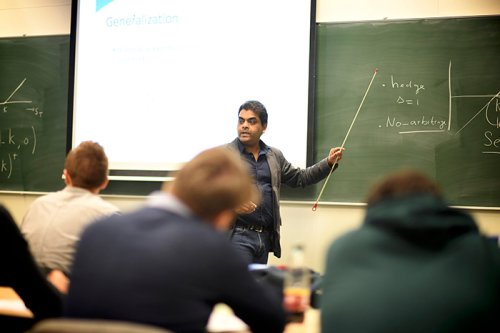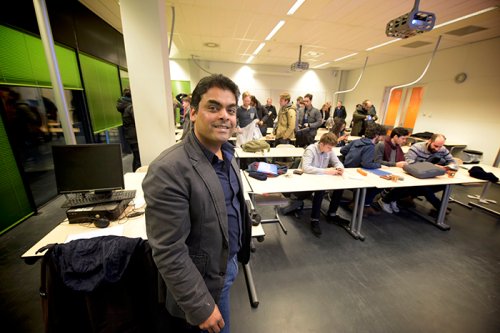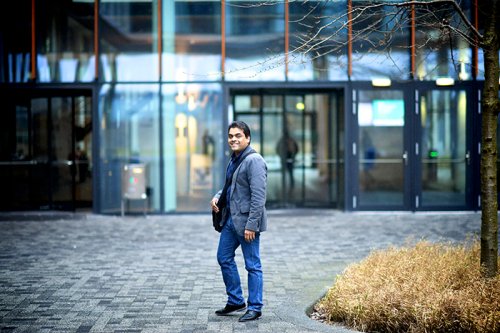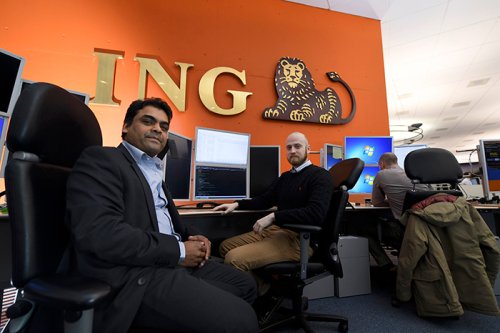Bring in the students
9 March 2017
For eight years, ING’s head of Quantitative Analytics Drona Kandhai has been teaching Computational Finance at the University of Amsterdam (UvA). In between classes, he explains what ING can learn from students.
It’s nine o’clock on a Friday morning and Drona Kandhai is not in the office.
Instead, he is taking his first sip of coffee at UvA’s Science Park in front of 50 technology students. He hasn’t quit his job, nor has he gone back to university. He’s just taking time off. To innovate.
Chalk – check, PowerPoint presentation and pointing stick – check, check. The students stop fidgeting so the lecture can begin.

There’s no better wake-up call on a Friday morning than a couple of algorithmic models.
Help me help you
For eight years, Kandhai has been splitting his time between leading the Amsterdam team of quantitative analysts at ING and teaching Computational Finance at UvA’s Faculty of Science. This specialisation, part of UvA’s Master’s programme in Computational Science, teaches students to build computational models from real-life observations. For example, using algorithmic and mathematical models to solve problems faced by the financial industry.
Kandhai’s dream has always been to set up a joint research programme between academic institutions and ING. And it materialised.
“It’s always been a passion of mine to connect academia with the industry and the other way around. I’ve been an assistant professor for years, but ever since my appointment as Computational Finance professor last December, I feel like I’ve reached a big milestone. That was the pinnacle,” he said.
What both ING and UvA had in mind was straightforward: a balanced partnership where their individual interests would be preserved. While ING is mostly after practical business solutions, an academic institution like UvA needs to keep an independent research agenda.

After following their progress throughout the semester, Kandhai selects a few students from each class to work with him at ING.
It didn’t take long before both parties recognised the value of collaborating. A few graduation assignments and traineeships later, the two stuck together.
“The partnership with UvA showed us the importance of bringing the academic world into ours. We get access to insights which help us find better solutions to our business problems, and students get access to first-hand experience not available in the classroom,” said Obbe Kok from ING’s Financial Markets team and one of the sponsors of this initiative.
To date, the partnership has seen more than 20 masters and 3 PhD graduates, half of whom joined ING in different departments such as Financial Markets, Risk, or IT.
From the lab to the field
The models that Kandhai develops with students can be applied broadly at ING. From financial markets, pricing and risk, to lending and payments. Building prototypes, however, is just the beginning of the innovation process.
Every lecture is followed by a lab session where he helps students check if assumptions made in class are also applicable in practice.
“I always bring in real cases from the industry. We constantly test our prototypes. This allows us to speed up progress.”
This trial-and-error approach – failing fast and celebrating small successes – keeps students motivated. If something’s not shaping up as originally planned, teams can immediately revisit their options.
“The easiest part of innovation is to show that something works in a lab. No matter how mind-blowing a new product is, it’s not an innovation unless it’s implemented into the day-to-day activities of a business,” said Kandhai. Tweet this
The most rewarding part of his job is to see prototypes being used by traders and risk managers. ING Financial Market’s pricing model ‘RaceING’ is a good example (see box-out).
Working for a bank?
Back in the classroom, Kandhai recaps the main points of the lecture and explains next week’s assignment. Given how the students react, the deadline seems tight!
Kandhai says staying close to the next generation of IT talent is not only inspiring or refreshing but vital to ING.
“The biggest threat for ING is not being able to attract the right people,” he explains.
Understandable. The financial sector isn’t exactly what you would call ‘the place to be’ for young talent looking for their first job. So how can ING win them over with this stiff competition from fintechs and tech giants such as Google, Netflix or Amazon?
“We can change things by being there among students. We need to connect with them, learn from them, and understand them. Most importantly, we need to keep an open mind. That’s the source of innovation.”

Kandhai before entering the UvA building: “We need to connect with students, learn from them, and understand them.”
At 11am sharp, he shuts down his laptop and puts the pointing stick back in his bag. A last sip of his cold coffee and he’s ready to roll up his sleeves to enter the lab session.

Arne Hollum (right) was writing his thesis when Kandhai made him an offer to work on a project for ING.
“I loved the creative freedom and the access to data and technology that I was given when I started here at ING,” said Hollum.
